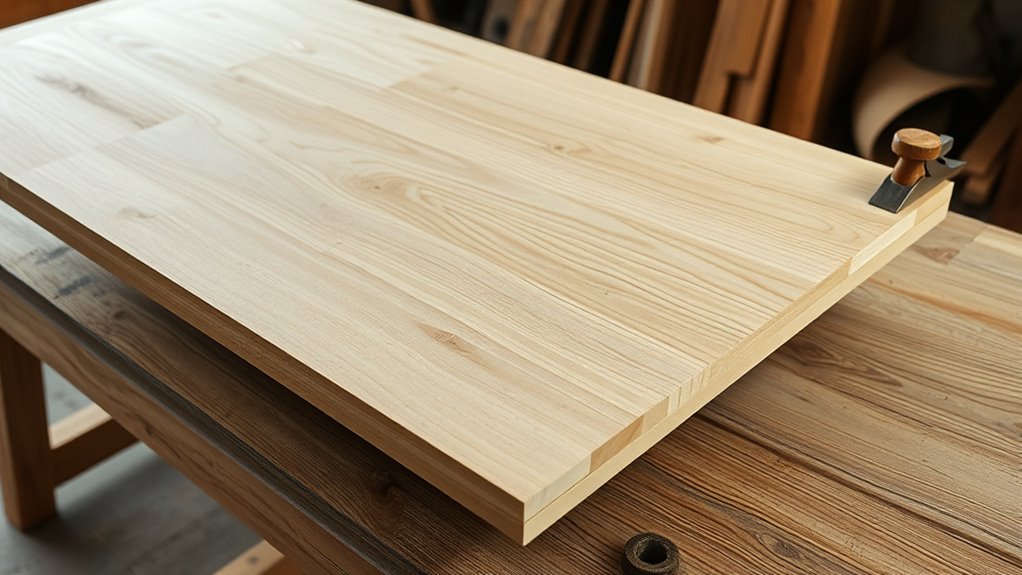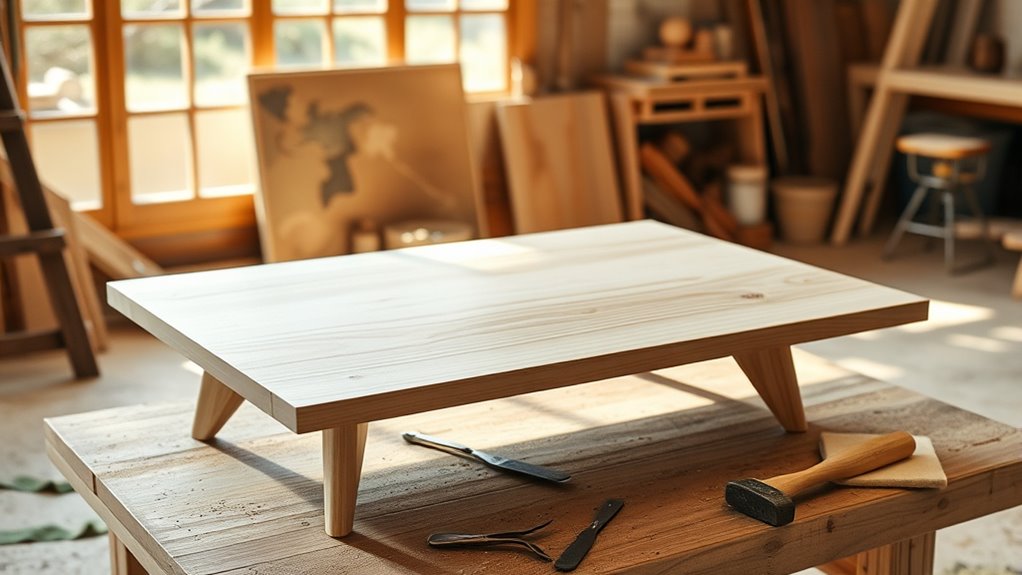To create a Japandi-style coffee table with simple tools, start by selecting sustainably sourced wood and deciding on a minimalist design with clean lines. Use a saw, drill, and sandpaper to cut and smooth your pieces, then assemble the table with screws or simple joinery methods. Finish with natural oils or beeswax to highlight the wood’s texture. If you continue, you’ll discover step-by-step tips for crafting a beautiful, eco-friendly table that complements a serene home.
Key Takeaways
- Select sustainably sourced wood with natural grain for a minimalist tabletop and legs.
- Use basic tools like a saw, drill, and sandpaper for precise cuts and smooth surfaces.
- Measure carefully and assemble the pieces securely with screws or joinery techniques.
- Finish with natural oils or beeswax to highlight texture and protect the wood.
- Keep hardware minimal and focus on clean lines to achieve the serene Japandi aesthetic.

If you’re drawn to the minimalist elegance of Japandi style, creating your own coffee table is a rewarding project you can tackle with just simple tools. This design aesthetic combines the clean lines of Scandinavian minimalism with the warm, natural appeal of Japanese craftsmanship. To achieve this look, focus on a minimalist design that emphasizes simplicity, functionality, and the use of sustainable materials. By choosing eco-friendly resources, you not only craft a beautiful piece but also contribute to a more sustainable environment.
Start by selecting your materials carefully. Opt for sustainably sourced wood such as bamboo, reclaimed pine, or FSC-certified hardwood. These choices ensure your project aligns with the eco-conscious principles of Japandi style. Keep your design simple: a rectangular or round tabletop paired with straight, sturdy legs works perfectly. Avoid ornate details or excessive adornments—less is more here. The beauty of minimalist design lies in its ability to highlight the natural grain and texture of the materials, so choose a finish that enhances these qualities. A light matte stain or natural oil will give your table a subtle, elegant look without overpowering its natural charm.
Choose sustainable woods like bamboo or reclaimed pine to create a simple, elegant Japandi coffee table.
When it comes to tools, you only need a few basics: a saw, a drill, sandpaper, a measuring tape, and a screwdriver. Use the saw to cut your wood pieces to size, making precise measurements to make certain of clean, straight edges. Sand all surfaces thoroughly to smooth out rough patches and prepare the wood for finishing. This step is essential for achieving that sleek, minimalist look. Once your pieces are prepared, assemble the tabletop and legs using screws or wood joinery techniques like dowels or mortise and tenon joints—these add stability without the need for complicated tools. Incorporating rustic decor elements such as subtle hardware or natural finishes can further enhance the aesthetic.
Finishing touches should also follow the minimalist ethos. Keep hardware minimal or hidden altogether. If you choose to add a protective finish, opt for natural oils or beeswax, which nourish the wood and bring out its inherent beauty. This approach not only preserves your sustainable materials but also maintains the understated aesthetic of Japandi design.
Creating your own coffee table allows you to personalize your space while practicing eco-friendly craftsmanship. The process is straightforward, requiring only simple tools and sustainable materials, yet the result is a stylish, functional piece that embodies the harmony of Japandi style. With patience and attention to detail, you’ll have a beautiful, minimalist coffee table that perfectly complements your home’s serene, elegant vibe.
Frequently Asked Questions
What Types of Wood Are Best for a Japandi-Style Coffee Table?
You should choose woods like oak, maple, or walnut for your Japandi-style coffee table. These woods have beautiful, subtle wood grain patterns that complement the minimalist aesthetic. They also take natural finishes well, highlighting their natural beauty. Opt for lighter tones like ash or birch if you prefer a softer look. Whichever you choose, guarantee the wood’s natural finish enhances its texture and simplicity, perfect for a serene Japandi vibe.
How Can I Customize the Size of My Coffee Table?
Think of your coffee table as a blank canvas ready for your touch. To customize its size, start with table height adjustments to match your space and comfort. Then, tailor the surface area by cutting your wood to desired dimensions before assembly. Measure carefully, double-check your plans, and use simple tools to create a piece that fits perfectly into your Japandi style. Your perfect table is just a few adjustments away.
What Are the Maintenance Tips for a Japandi-Style Table?
To keep your Japandi-style table looking its best, follow a simple cleaning routine with a soft, damp cloth and mild soap. Avoid harsh chemicals that can damage the finish. Apply protective finishes like wax or oil periodically to maintain its luster and durability. Keep it away from direct sunlight and moisture, and promptly wipe up spills to prevent stains. Regular maintenance guarantees your table stays beautiful and functional for years.
Can I Incorporate Metal Accents Into the Design?
Yes, you can definitely incorporate metal accents into your Japandi design. Use sleek, minimalist metal details like thin legs, handles, or decorative trims to enhance the aesthetic. Focus on subtlety and balance to maintain the clean, serene look of Japandi style. Metal accents should complement the wood tones without overpowering them, creating a harmonious design integration that adds modern sophistication while preserving the simplicity of the overall look.
What Safety Precautions Should I Follow During Assembly?
When assembling your coffee table, always wear protective gear like safety glasses and gloves to prevent injuries. Keep your workspace organized and free of clutter to avoid accidents. Use tools carefully and follow the manufacturer’s instructions. Make certain of proper lighting and ventilation. Take your time, and don’t rush the process. Prioritizing workspace safety helps you stay safe and makes your project more enjoyable and successful.
Conclusion
By following these simple steps, you can craft a stunning Japandi-style coffee table that perfectly blends minimalism and warmth. Imagine Sarah, a beginner woodworker, who built her own table using just basic tools; now, her living room feels more inviting and stylish. With patience and care, you’ll create a beautiful piece that reflects your taste and enhances your space. So, grab your tools and start designing your own timeless, functional centerpiece today.






